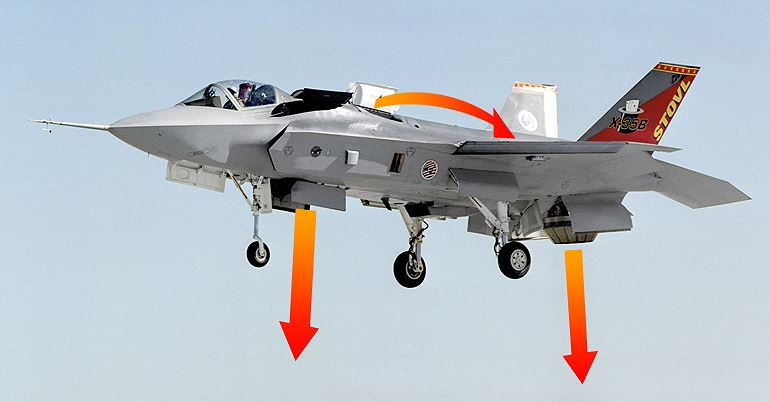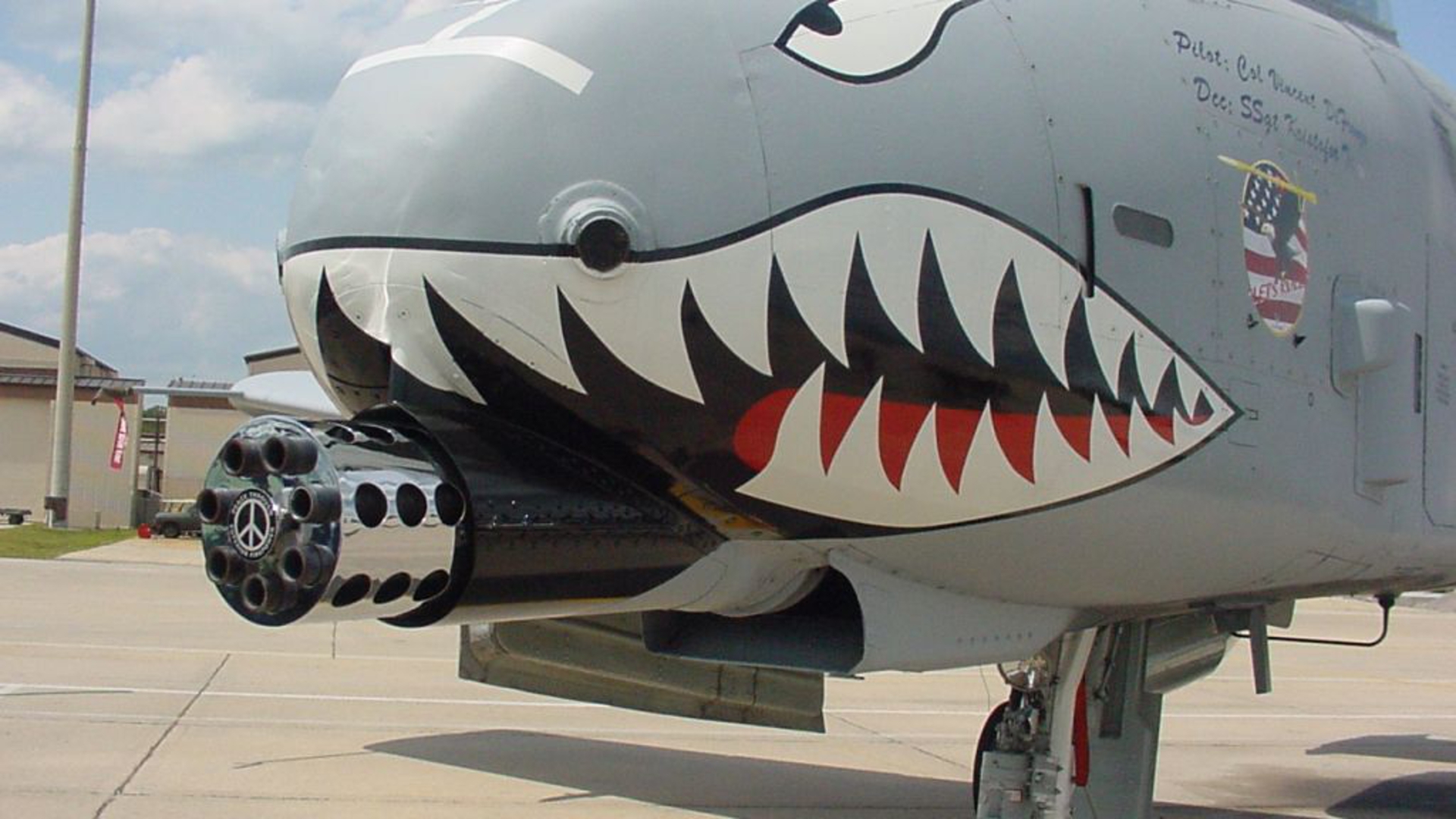The F-35 Lightning II is supposed to be America’s primary warplane for the next several decades. But here’s one big problem. The F-35 can catch on fire … just while trying to take off.
That’s what happened on June 23, 2014, when a fire swept through an F-35 fighter jet taxiing on a runway at Eglin Air Force Base in Florida. A new report by the U.S. Air Force’s Accident Investigation Board shines new light on what exactly happened with America’s hottest new warplane.
The military classifies the fire as a “Class A Mishap,” meaning an accident that causes death, permanent injury or costs $2 million or more in damage. According to the report, this particular incident cost the Department of Defense “in excess of” $50 million in damage.
And it could happen again.

Here’s how the Air Force investigators described the incident. The aircraft was scheduled to fly as part of a four plane training sortie. But prior to takeoff, two aircraft slated for the flight “had slight maintenance delays.”
Air Force officials decided to press on with the mission, sending out a two plane sortie instead. The “mishap aircraft” — as it’s referred to in the report — was to be the second ship of the two-ship formation.
But as the plane went down the runway, its engine stalled. Fire warning systems began blaring, the pilot shut down the engine and then bailed out of the cockpit. As he escaped, the flames quickly grew into an inferno.
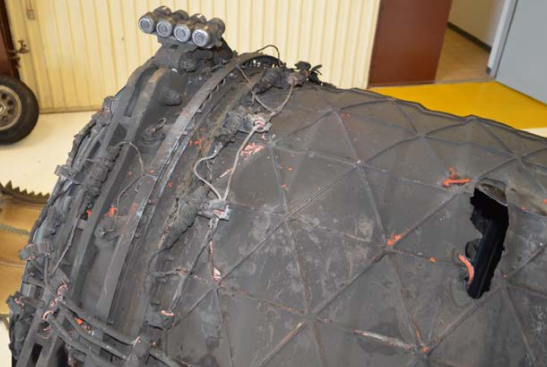

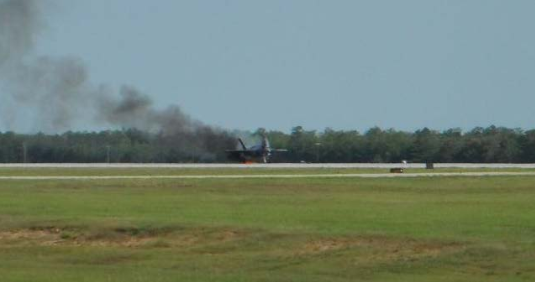
At top — the F-35 after a June 24, 2013 engine fire. From left —the perforated engine, burned fuselage and blaze on the runway. Air Force photos
“Leaking fluids continued to burn on and around the aircraft,” the report recounted. “The fire damaged the aft two thirds of the aircraft before emergency responders were able to extinguish it.” Firefighters managed to put out the flames “about seven minutes after the initial indications of a fire.”

What happened is not entirely surprising. Some personnel and testers have already raised concerns that the F-35 engine — known as the F135 — is prone to safety hazards.
As early as the 2007 fiscal year, engineers warned that a serious fire could break out if fuel leaked into the engine compartment, according to the latest annual report from the Pentagon’s top weapons tester.
By Fiscal Year 2013, tests had confirmed these fears. “Engine live fire tests in FY13 and prior live fire test data and analyses demonstrated vulnerability to engine fire, either caused by cascading effects or direct damage to engine fuel lines,” the report noted.
But it was the 2014 Eglin incident that brought the fire concerns into the limelight. Then, one of the engine’s fan blades broke off and flew through the plane’s fuselage. As predicted, the rear portion of the aircraft burst into flames as burning fuel filled the compartment.
“The uncontained F135 fan blade release and subsequent fuel fire in an F-35A at Eglin AFB in June provides an additional data point that needs to be reviewed and analyzed to support the F-35 vulnerability assessment,” the military’s lead weapons tester concluded.
The language in that statement implies that despite years of testers raising concerns about this exact scenario, the Pentagon had not made it priority. The catastrophic failure was also not caused by human error. Investigators interviewed everyone involved with maintaining and operating the aircraft at Eglin.
“[The] Accident Investigation Board interviews of maintenance personnel … reflect qualified and competent maintenance personnel with appropriate supervision,” the Air Force’s report on the Eglin incident stated. “There is no evidence to suggest that maintenance personnel and supervision were a factor in this mishap.”
Buy ‘Grounded: The Case for Abolishing the United States Air Force.’
That means even when the plane is entrusted with experienced and capable personnel, the F-35— which is to eventually cost American taxpayers more than a trillion dollars — will still occasionally catch on fire all by itself.
https://medium.com/war-is-boring/th...ce430792b?mc_cid=b92c0f17f6&mc_eid=83d96bf5c9
الملخص
عموما الحادثة ليست بالجديدة
ولكن الجديد هو علم البنتاجون بمشاكل فى المحرك ونظام تزويد المحرك بالوقود مما يسبب نشوب حريق فى المحرك
وقد حذر المهندسون من ذلك عام 2007
وفى عام 2013 خرج تقرير يفيد بان المقاتلة قد تكون عرضة للاحتراق نتيجة التقادم او مشاكل فى خطوط الوقود الداخلية عموما
لتقع الحادثة فى منتصف العام الماضى حيث تطايرت احدى مرواح المحرك لتحدث حريق هوت على اثره المقاتلة بعد ان كانت على وشك الاقلاع
وسيتم التخلص منها لصالح مقاتلات اخرى كقطع غيار
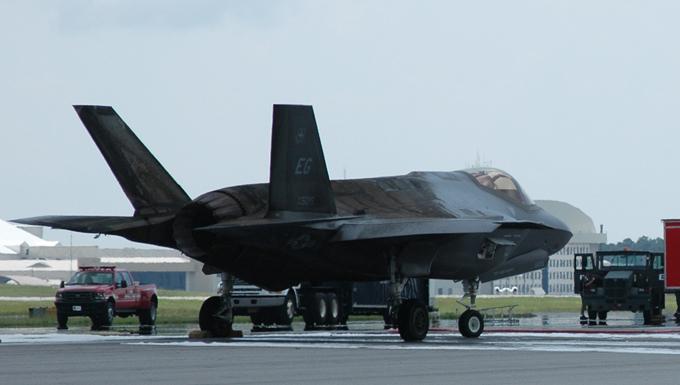
That’s what happened on June 23, 2014, when a fire swept through an F-35 fighter jet taxiing on a runway at Eglin Air Force Base in Florida. A new report by the U.S. Air Force’s Accident Investigation Board shines new light on what exactly happened with America’s hottest new warplane.
The military classifies the fire as a “Class A Mishap,” meaning an accident that causes death, permanent injury or costs $2 million or more in damage. According to the report, this particular incident cost the Department of Defense “in excess of” $50 million in damage.
And it could happen again.

Here’s how the Air Force investigators described the incident. The aircraft was scheduled to fly as part of a four plane training sortie. But prior to takeoff, two aircraft slated for the flight “had slight maintenance delays.”
Air Force officials decided to press on with the mission, sending out a two plane sortie instead. The “mishap aircraft” — as it’s referred to in the report — was to be the second ship of the two-ship formation.
But as the plane went down the runway, its engine stalled. Fire warning systems began blaring, the pilot shut down the engine and then bailed out of the cockpit. As he escaped, the flames quickly grew into an inferno.



At top — the F-35 after a June 24, 2013 engine fire. From left —the perforated engine, burned fuselage and blaze on the runway. Air Force photos
“Leaking fluids continued to burn on and around the aircraft,” the report recounted. “The fire damaged the aft two thirds of the aircraft before emergency responders were able to extinguish it.” Firefighters managed to put out the flames “about seven minutes after the initial indications of a fire.”

What happened is not entirely surprising. Some personnel and testers have already raised concerns that the F-35 engine — known as the F135 — is prone to safety hazards.
As early as the 2007 fiscal year, engineers warned that a serious fire could break out if fuel leaked into the engine compartment, according to the latest annual report from the Pentagon’s top weapons tester.
By Fiscal Year 2013, tests had confirmed these fears. “Engine live fire tests in FY13 and prior live fire test data and analyses demonstrated vulnerability to engine fire, either caused by cascading effects or direct damage to engine fuel lines,” the report noted.
But it was the 2014 Eglin incident that brought the fire concerns into the limelight. Then, one of the engine’s fan blades broke off and flew through the plane’s fuselage. As predicted, the rear portion of the aircraft burst into flames as burning fuel filled the compartment.
“The uncontained F135 fan blade release and subsequent fuel fire in an F-35A at Eglin AFB in June provides an additional data point that needs to be reviewed and analyzed to support the F-35 vulnerability assessment,” the military’s lead weapons tester concluded.
The language in that statement implies that despite years of testers raising concerns about this exact scenario, the Pentagon had not made it priority. The catastrophic failure was also not caused by human error. Investigators interviewed everyone involved with maintaining and operating the aircraft at Eglin.
“[The] Accident Investigation Board interviews of maintenance personnel … reflect qualified and competent maintenance personnel with appropriate supervision,” the Air Force’s report on the Eglin incident stated. “There is no evidence to suggest that maintenance personnel and supervision were a factor in this mishap.”
Buy ‘Grounded: The Case for Abolishing the United States Air Force.’
That means even when the plane is entrusted with experienced and capable personnel, the F-35— which is to eventually cost American taxpayers more than a trillion dollars — will still occasionally catch on fire all by itself.
https://medium.com/war-is-boring/th...ce430792b?mc_cid=b92c0f17f6&mc_eid=83d96bf5c9
الملخص
عموما الحادثة ليست بالجديدة
ولكن الجديد هو علم البنتاجون بمشاكل فى المحرك ونظام تزويد المحرك بالوقود مما يسبب نشوب حريق فى المحرك
وقد حذر المهندسون من ذلك عام 2007
وفى عام 2013 خرج تقرير يفيد بان المقاتلة قد تكون عرضة للاحتراق نتيجة التقادم او مشاكل فى خطوط الوقود الداخلية عموما
لتقع الحادثة فى منتصف العام الماضى حيث تطايرت احدى مرواح المحرك لتحدث حريق هوت على اثره المقاتلة بعد ان كانت على وشك الاقلاع
وسيتم التخلص منها لصالح مقاتلات اخرى كقطع غيار



